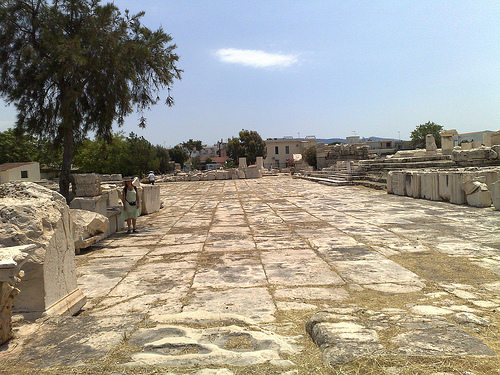

Location: 22 km (14 mi) Northwest of Athens
Found: around 1700
BC
Tel. 210 554 6019
Open: 8:30am- 3pm Tue- Sun
Closed:
public holidays
Most famous for Eleusian Mysteries
The
Archaeological Site of Eleusis (also known as Elefsina) is one of
ancient Greece's most significant religious sanctuaries, dedicated
primarily to the goddesses Demeter and Persephone (Kore). Located in
West Attica, it was the epicenter of the Eleusinian Mysteries—a
secretive initiation cult promising initiates a blessed afterlife
and tied to themes of agriculture, fertility, death, and rebirth.
Spanning from prehistoric times through the Roman era, the site
encompasses ruins of temples, fortifications, processional paths,
and ritual spaces across a vast area at the foot of an ancient
acropolis hill. An on-site museum, one of Greece's oldest, displays
artifacts that illuminate the site's history and the mysteries'
enigmatic rites. Though less crowded than Athens' Acropolis, Eleusis
offers profound insights into ancient Greek spirituality and
mythology, with well-preserved structures amid a post-industrial
landscape. Visitor ratings average 4.2 out of 5 on Tripadvisor
(based on 184 reviews), earning a Travelers’ Choice award for its
cultural depth, though some note the need for prior research to
fully appreciate its symbolism.
Eleusis's mythological roots stem from the Homeric Hymn to Demeter,
where the goddess, grieving the abduction of her daughter Persephone by
Hades, rested at the Kallichoron Well after her search. In gratitude for
local hospitality, Demeter taught the Eleusinians her mysteries,
establishing the cult. The site likely began with primordial worship in
natural caves, evolving into a structured sanctuary by the late
Geometric period (8th century BCE), with early artifacts like bird-like
figurines from sacrificial fires.
Independent until the 7th century
BCE, Eleusis was annexed by Athens, integrating the mysteries into a
major pan-Hellenic festival. The late 6th century BCE saw Peisistratean
fortifications enclosing the city and sanctuary. The Classical period
(5th century BCE) brought expansions, including the Telesterion by
architect Ictinos (of Parthenon fame) and Cimon's North Pylon. After the
Peloponnesian War, brief independence under the Thirty Tyrants in 403
BCE was short-lived, with Athenian control restored.
The 4th century
BCE added the Portico of Philo and Bouleuterion. Roman influence peaked
in the 2nd century CE with triumphal arches, the Greater Propylaea
(modeled after Athens' Acropolis), and temples like that of Sabina
(Hadrian's wife). The site thrived as a pilgrimage center until AD 395,
when Gothic leader Alaric destroyed it, leading to abandonment until the
18th century revival as modern Elefsina. Excavations began in the 19th
century, uncovering layers of Greco-Roman ruins. Eleusis was also the
birthplace of playwright Aeschylus, the "father of tragedy."
Eleusis lies in Elefsina (modern name), West Attica, about 20 km west
of Athens, at the foot of an ancient acropolis hill now topped by the
church of Panagia Mesosporitissa. Coordinates are approximately 38°02′N
23°32′E, near the Saronic Gulf in a once-fertile plain ideal for
Demeter's agricultural cult. The site's layout follows a processional
axis from the Sacred Way (linking to Athens) into the sanctuary, curving
around rocky slopes to the central Telesterion.
Key buildings include
the Roman Court (a 65m x 40m paved square with marble slabs, flanked by
porticoes and arches); Greater and Lesser Propylaea (monumental
gateways, the latter dedicated by Roman consul Appius Claudius Pulcher
in 54 BCE); Telesterion (initiation hall, 5th century BCE, with Ictinos'
design); Portico of Philo (4th century BCE Doric addition to the
Telesterion); Ploutonion (caves and temple to Pluto at the acropolis
foot); Temple of Artemis Propylaia and Poseidon (2nd century CE marble
platform); and Bouleuterion (4th century BCE council house).
Fortifications like the Peisistratean walls and extensions enclose the
area, with features like the Roman Cistern for water storage and Siroi
(magazines) for grain offerings.
The acropolis hill integrates
natural elements, such as caves symbolizing the underworld, with built
structures. External areas beyond the arches housed baths, hotels, and
public buildings for pilgrims.
The site's features emphasize ritual: the Sacred Court for gatherings
and altars; Processional Road lined with statue pedestals; Kallichoron
Well for mythic dances; Eschara (Roman altar); and a fountain for
purification. The layout supported the mysteries' secrecy, with the
Telesterion as the core for initiations. Natural integration, like the
Ploutonion caves, evoked chthonic themes.
The on-site
Archaeological Museum, built in 1889 by Ioannis Moussis, is a stone
ground-floor structure with six rooms (expanded in the 1930s). It houses
finds from the sanctuary and nearby cemeteries, including pottery,
statues, and plaster models by Ioannis Travlos reconstructing the site.
Exhibits cover prehistoric to Roman eras, with digital simulations and
high-tech displays added post-1999 earthquake renovations. The museum
reopened in March 2023 after updates.
Standouts include the Caryatid from the Lesser Propylaea (ca. 50 BCE, resembling Acropolis figures, with a gorgon head and sacred cista; one "sister" removed in 1801); bird-like figurines and vessels from late Geometric sacrificial fires in the Telesterion area; pottery from the Western Cemetery tombs (linked to the "Seven against Thebes" myth); and inscriptions like the Latin dedication on the Lesser Propylaea. Other items: dedications along the Processional Road, altars from the Sacred Court, and reliefs depicting mysteries' elements.